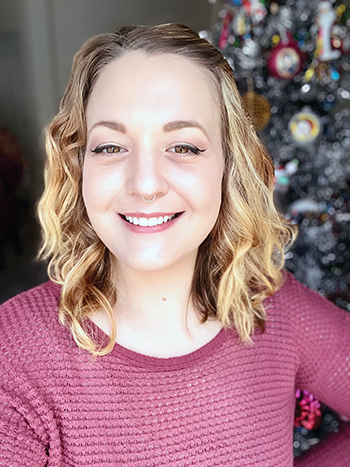Hodgkin Lymphoma Survivor
Diagnosis fuels passion for helping others

Chelsey Gomez’s Hodgkin lymphoma diagnosis at 28 was life-changing in many ways. She channeled all her emotions and energy into a new career dedicated to making life better for adolescents and young adults (AYAs) facing cancer.
Being excessively tired, losing weight and having itchy legs were my first symptoms. When I found a lump on the left side of my neck, I went to Urgent Care. High-dose antibiotics did nothing, so my family encouraged me to go to the ER. I still feel bad for the young doctor who told me there were masses all over my chest. I was admitted for a surgical biopsy. Two days later, my husband and I were eating at a restaurant when I got a notification on my medical portal that I’d been scheduled for a PET and bone marrow biopsy. That is how I learned I had Hodgkin lymphoma.
I met with an oncologist who felt we had to move quickly. In his opinion, I had about seven months to live without treatment. He started me on a combination chemotherapy regimen. After five treatments I had an allergic reaction to one of the drugs. He felt strongly we needed to get the treatment completed, so I powered on. After 12 treatments, I had my port taken out and rang the bell. Six weeks later, I went back to work. I wanted to pretend like none of it had ever happened.
Three months later, another mass was found. I never felt my oncologist was engaged or interested in answering my questions, so I sought a second opinion at a well-known cancer center. I think it was fate because the oncologist I’m still with today was able to fit me in on a day that wasn’t typically open. After new tests confirmed it was Hodgkin lymphoma, I began immunotherapy, but it did absolutely nothing to the cancer. That really scared me. It was the first time I thought maybe I wasn’t going to make it.
Inpatient chemotherapy and an autologous stem cell transplant were next. With the chemotherapy, my hair fell out in clumps, just like on TV. After two treatments, I was ready for the transplant. As I was having my cells collected, COVID-19 hit. Our three-year-old daughter was with my mom, and my husband and I were staying in free patient housing near the hospital. Because of COVID, it was forced to close, so we had to rent a very expensive Airbnb. It seemed fitting that I had my transplant on April Fool’s Day.
My husband was my caregiver post-transplant. I’ve known him since we were very young. From childhood challenges to cancer, he’s been my angel on earth sent to help me. I couldn’t have done any of this without him.
Cancer is so unpredictable. I was an insurance adjuster, and I couldn’t give my employer exact dates on when I would return to work. They didn’t work with me during my treatment, and I felt they didn’t value me as a person even though I’d been a loyal employee for seven years. My husband encouraged me to live for myself for the moment. So, three months after the transplant, I quit. It was a turning point for me.
We were keeping our daughter at home because we couldn’t risk her getting or bringing home COVID, and that gave me about a year to figure out a career that would make me happy. It didn’t take long.
I had so many emotions after treatment. I was scared, angry, unsure … I had all the feelings, but they didn’t fit with the typical “cancer warrior” mentality. I’ve always been creative and have always doodled, so I used my love of art to express my range of emotions creatively. I downloaded a drawing program and began to draw the way I felt inside about cancer.
I posted my funny, inspirational and sarcastic artwork on social media under the name “ohyouresotough,” hoping other people in the cancer community would feel the same way. People really responded! I think it was a safer way to share honest and sometimes terrifying feelings rather than speaking them out loud. And when you see that other people feel the same way you do, it’s really freeing. I am very proud and grateful for the supportive community that has formed around my work.
Sharing my art online led to the founding of my non-traditional cancer brand under the same name. I started designing humorous fun products that I wished existed during my cancer experience. It’s touching to be a part of so many people’s special moments, such as finishing chemotherapy, through my products. I am always thrilled when I am tagged in photos of these events on social media.
I also write children’s books that teach kids about cancer. I contribute articles for Elephants & Tea magazine and co-founded an art program for AYA patients with Gilda’s Club. I share resources with my community frequently and lend my voice to many conversations about AYA patient care. I am also involved in research regarding the AYA experience and helping to design materials that are patient-friendly.
Although it helps me to help others, I know it’s necessary to focus on healing myself too. I see a therapist and make my emotional health a priority. My goal is to leave behind something positive.


